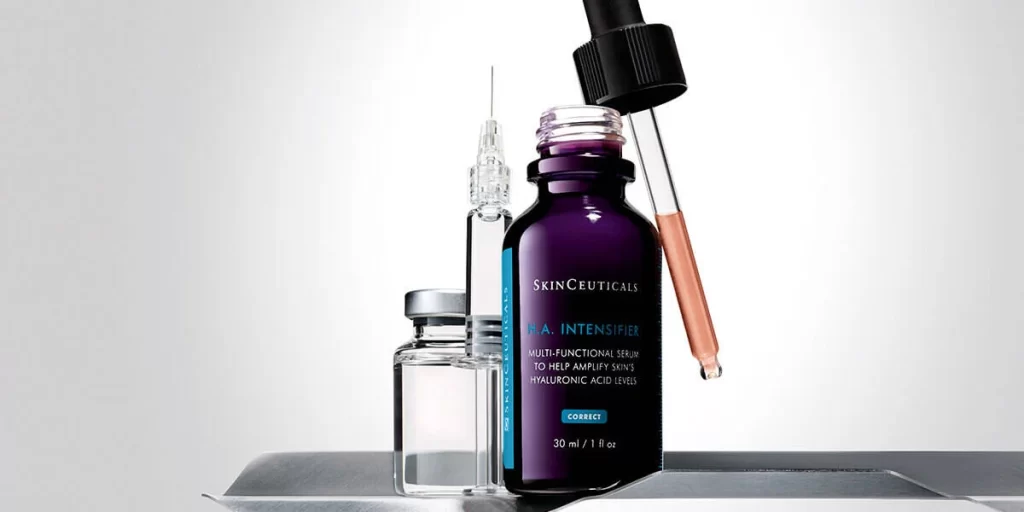Understanding Hyaluronic Acid
Natural Occurrence
Hyaluronic acid is a substance found naturally in the human body and is used in collagen products, filler injections, and injectable fillers. It is present in connective tissues, skin, and eyes. This molecule holds water, keeping tissues hydrated and lubricated.
In the skin, hyaluronic acid helps maintain moisture. It provides volume and elasticity. As we age, natural levels of hyaluronic acid decrease. This leads to drier skin and wrinkles.
Composition Differences
Hyaluronic acid fillers differ from other dermal fillers. They are made from synthesized hyaluronic acid, mimicking the body’s own substance, used in filler injections and lip augmentation. Other fillers might use collagen or calcium hydroxylapatite.
HA fillers are gel-like and smooth. They integrate well with the skin’s natural structure. Unlike some other fillers, such as collagen products, they do not cause allergic reactions or hypersensitivity because they are biocompatible.
Effects on Skin
Injectable hyaluronic acid has immediate effects on the skin. It plumps up areas with lost volume. Wrinkles and fine lines on the face become less visible right after treatment with hyaluronic acid filler.
The hydration effect is also instant. The skin appears smoother and more youthful quickly. These results can last from six months to a year depending on the hyaluronic acid filler used, with potential site reactions and hypersensitivity reactions affecting duration.
Aging Face Treatment
Volume Loss
Hyaluronic acid (HA) fillers address age-related volume loss. As we age, our face loses fat and collagen. This can lead to a sunken appearance. HA fillers restore this lost volume. They provide structural support to the skin.
The fillers are injected into specific areas of the face, including folds and malar edema. This helps in lifting and plumping up the skin. Malar edema, or swelling in the cheek area, can also be reduced with HA fillers, a clinical example that may involve complications and reactions. The results are usually immediate.
Fine Lines and Wrinkles
HA fillers are effective for treating fine lines, wrinkles, and folds in the treatment area. These include perioral lines around the mouth and nasolabial folds between the nose and mouth, a clinical example where hyaluronic acid filler can cross and reduce edema. The fillers smooth out these lines by adding volume beneath them, et al.
Fine lines can appear due to reduced collagen production over time, potentially treated with hyaluronic acid filler in clinical settings. HA fillers stimulate natural collagen production in the skin. This leads to long-lasting improvements in skin texture.
Facial Folds
Deep facial folds benefit greatly from HA filler treatments. Nasolabial folds, which run from the sides of the nose to the mouth corners, are common clinical concerns as we age and may be treated with hyaluronic acid filler. HA fillers fill in these deep creases, making them less noticeable in clinical settings, et al.
The treatment is minimally invasive and requires little downtime. Patients can return to their daily activities almost immediately after clinical treatment with hyaluronic acid filler.
Customization
HA filler treatments are highly customizable. Different types of HA fillers cater to various clinical aging concerns.
-
Lip enhancement: For fuller lips.
-
Cheek augmentation: For higher cheekbones.
-
Perioral lines: For smoother skin around the mouth.
Each patient receives a tailored clinical treatment plan based on their unique needs and goals.
Benefits for Appearance
Smoother Skin
Hyaluronic acid (HA) fillers help smooth out the skin. They fill in fine lines and creases, making the skin look clinically younger. HA attracts water to the skin, which adds volume. This process helps reduce wrinkles.
People often use HA fillers to treat clinical areas around the mouth and eyes. These areas show signs of aging first. By using clinical HA fillers, individuals can achieve a more youthful appearance without surgery.
Enhanced Facial Contours
HA fillers also enhance facial contours. They add volume to areas like cheeks and lips. This results in a fuller and more defined look.
The effects are immediate and natural-looking. Many people choose HA fillers over surgical options because they offer subtle clinical improvements. The procedure is quick, with minimal downtime.
Hydrated Appearance
Hyaluronic acid is known for its clinical ability to retain moisture. It can hold up to 1,000 times its weight in water, making it ideal for clinical use. When used as a clinical filler, it keeps the skin hydrated.
This clinical hydration gives the skin a plump and healthy glow. Hydrated skin looks fresher and more vibrant. Over time, this can improve overall skin texture.
Natural-Looking Results
One major clinical benefit of HA fillers is their natural-looking results. Unlike some other treatments, HA fillers blend well with the skin’s natural tissues in clinical settings.
They provide gradual improvements rather than drastic changes. This makes them ideal for those looking for subtle clinical enhancements.
Non-Surgical Option
HA fillers offer a non-surgical alternative for clinical cosmetic improvements. Procedures are typically done in a doctor’s clinical office and take less than an hour.
Recovery time is short; most people resume normal clinical activities right away. Side effects are minimal but may include mild swelling or redness at the clinical injection site.
By opting for HA fillers, individuals avoid the risks associated with surgery. There’s no need for anesthesia or long recovery periods.
Types of Fillers
Belotero Balance
Belotero Balance is a popular hyaluronic acid filler. It integrates smoothly into the skin. This makes it ideal for treating fine lines and delicate areas. It is often used around the eyes and lips. The results of Belotero Balance can last up to six months.
Juvederm
Juvederm is another well-known HA filler. It has different formulations for various needs. Juvederm Ultra XC is great for lip augmentation. Juvederm Voluma XC adds volume to the cheeks. These fillers can last from six months to two years, depending on the type.
Restylane
Restylane offers several options as well. Restylane Lyft is used for cheek enhancement and midface contouring. Restylane Silk focuses on smoothing out wrinkles around the mouth. Results from Restylane fillers typically last between six to eighteen months.
Longevity Comparison
The longevity of HA fillers varies by brand and type:
-
Belotero Balance: Up to six months.
-
Juvederm: Six months to two years.
-
Restylane: Six to eighteen months.
Each filler has its own duration based on its formulation and application area.
Specific Applications
Different fillers suit different treatment areas:
-
Fine Lines: Belotero Balance works best.
-
Lips: Juvederm Ultra XC and Restylane Silk are common choices.
-
Cheeks: Juvederm Voluma XC and Restylane Lyft are preferred.
Choosing the right filler depends on the specific area being treated and desired outcomes.
Treatment Area Considerations
Selecting a filler involves considering the treatment area:
-
Eyes: Fine lines around the eyes benefit from smooth, thin fillers like Belotero Balance.
-
Lips: Plumping lips requires more robust options like Juvederm Ultra XC or Restylane Silk.
-
Cheeks: Adding volume to cheeks needs thicker fillers such as Juvederm Voluma XC or Restylane Lyft.
Each area requires specific properties in a filler for optimal results.
Composition Details
Material Content
Hyaluronic acid fillers are synthetic. They mimic the body’s natural hyaluronic acid (HA). This makes them highly compatible with human tissue.
HA fillers contain cross-linked HA molecules. Cross-linking stabilizes the molecules, increasing their longevity in the skin. The particle size and concentration of HA can vary between products. This affects their behavior and suitability for different areas.
Production Process
The production of HA fillers involves bacterial fermentation. Streptococcus bacteria produce HA through this method. Post-production, the HA undergoes purification to remove impurities. This ensures safety and effectiveness for use in humans.
Different brands may have unique processes. For example, some might include additional steps to enhance purity or modify particle size.
Hydration Properties
One key feature of HA is its ability to attract and retain water. Each molecule can hold up to 1,000 times its weight in water. This helps maintain skin hydration and volume.
In cases where lost volume needs restoration, HA fillers are ideal. They provide immediate plumping effects by drawing moisture into the treated area.
Temporary Nature
HA fillers are not permanent solutions. The body gradually absorbs them over time. Typically, results last from six months to a year.
The duration depends on various factors:
-
Treatment site
-
Individual metabolism
-
Type of filler used
Regular touch-ups are necessary to maintain desired results.
Site Reactions and Complications
While generally safe, HA fillers can cause side effects at the injection site:
-
Redness
-
Swelling
-
Bruising
These reactions are usually mild and temporary. However, more severe complications like infection or granulomas can occur but are rare.
A review by Sundaram et al., 2010 noted that most complications arise from improper technique or unsterile conditions.
Application Areas
HA fillers treat various facial areas effectively:
-
Nasolabial folds
-
Cheeks
-
Lips
Each area may require different types of fillers based on volume needed and particle size suited for that site.
Choosing the Right Filler
Treatment Area
Different areas of the face may require different types of hyaluronic acid fillers. Lip enhancements often use fillers with smaller gel particle sizes. These provide a smoother, more natural look. For deeper wrinkles or volume loss in cheeks, larger gel particles work better. They offer more structural support.
Desired Longevity
The longevity of the filler depends on its formulation and placement. Some fillers last for six months, while others can last up to two years. If you want a temporary change, choose a shorter-lasting filler. For longer results, opt for fillers designed to last longer.
Aesthetic Goals
Your aesthetic goals influence the choice of filler. For subtle enhancements, lightweight fillers are ideal. They blend well with your natural features. For dramatic changes, denser fillers provide more noticeable results.
Consulting Specialists
Consulting with a qualified specialist is crucial. Specialists can assess your skin type and age to recommend the best filler products for you. They also consider any previous treatments you’ve had.
Skin Type and Age
Skin type and age play significant roles in choosing an HA filler. Younger skin may respond well to lighter fillers that provide hydration and minor plumping. Older skin might need thicker fillers to address deeper lines and volume loss.
Treatment Procedure
Consultation
Patients first consult with a healthcare provider. The doctor reviews the patient’s medical history. They discuss goals and expectations. This step ensures suitability for the treatment.
Preparation
Before the procedure, the treatment area is cleaned. Doctors may apply a numbing cream to minimize discomfort. Skin testing is rare but can occur if there’s allergy concern.
Injection Procedure
The actual injection takes about 15-30 minutes. Doctors use fine needles or cannulas to inject hyaluronic acid fillers into the skin. They target specific areas to achieve desired results. Multiple injections may be necessary.
Patient Comfort
Patient comfort is crucial during the procedure. Using numbing agents helps reduce pain. Some fillers contain lidocaine, an anesthetic, to enhance comfort.
Minimal Downtime
One advantage of HA fillers is minimal downtime. Patients can resume daily activities immediately after treatment. Mild swelling or redness at the injection site may occur but usually subsides quickly.
Side Effects
Common side effects include:
-
Swelling
-
Redness
-
Bruising
-
Tenderness
These typically resolve within a few days. Following aftercare instructions helps minimize these effects.
Aftercare Instructions
Patients should avoid strenuous activities for 24 hours post-treatment. Applying ice packs can reduce swelling and bruising. Avoid touching or massaging the treated area to prevent filler displacement.
Expectations and Duration
Immediate Results
Hyaluronic acid (HA) fillers provide immediate results. Patients often see a noticeable difference right after the treatment. The skin looks plumper, and wrinkles appear smoother. However, some swelling or redness may occur initially. These reactions are normal and typically subside within a few days.
Longevity of Effects
The duration of HA fillers varies. It depends on several factors:
-
Type of filler used: Different brands have different longevity.
-
Treatment area: Fillers in high-movement areas like lips may not last as long.
-
Patient’s metabolism: Faster metabolism can break down fillers quicker.
Generally, HA fillers last between 6 months to 1 year. Some advanced products can last up to 18 months.
Maintenance Treatments
To maintain desired results, regular follow-up treatments are necessary. Without maintenance, the effects will gradually fade as the body absorbs the filler material. Most patients schedule touch-ups every 6 to 12 months.
Potential Risks
While HA fillers are generally safe, there are potential risks:
-
Hypersensitivity reactions: Some individuals might experience allergic responses.
-
Adverse events: Bruising, swelling, or infection can occur but are rare.
-
Long-term risks: Over time, repeated treatments could lead to uneven texture or lumps under the skin.
It’s crucial to choose a qualified professional for the procedure to minimize these risks.
Signs of Complications
Watch for signs that need medical attention:
-
Persistent pain
-
Severe swelling
-
Unusual redness
-
Lumps or bumps that do not smooth out
These symptoms could indicate complications needing prompt treatment.
Finding a Specialist
Qualified Expert
Choose a qualified doctor for HA filler treatments. Look for board-certified dermatologists or plastic surgeons. They should have specific training in cosmetic procedures. Verify their credentials and experience.
Ask about their professional affiliations. Membership in relevant societies indicates ongoing education. Examples include the American Society for Dermatologic Surgery (ASDS) or the American Board of Cosmetic Surgery (ABCS).
Experience Matters
Experience is crucial. A specialist with years of practice will handle complications better. They understand different skin types and needs.
Inquire about the number of procedures they have performed. More experience often means better results. Ask to see before-and-after photos of previous patients.
Understanding HA Fillers
A good specialist knows various HA fillers available. Each filler has unique properties and uses. Some are better for deep wrinkles; others are ideal for fine lines.
Ensure the specialist explains which filler suits your needs best. They should consider factors like skin type, age, and treatment area.
Personalized Consultations
Seek specialists who offer personalized consultations. Personalized consultations help discuss individual needs and expectations clearly.
During the consultation, talk about your goals and concerns. The specialist should provide honest advice on what to expect from the treatment.

Safety Precautions
Safety is paramount in cosmetic treatments. Choose a specialist who follows strict safety protocols.
Ask if they conduct allergy tests before using fillers to avoid hypersensitivity reactions. Ensure they use FDA-approved products only.
Reviews and Recommendations
Check online reviews and testimonials from previous patients. Positive feedback can indicate reliable service.
Ask friends or family for recommendations if they have had similar treatments done successfully.
Final Remarks
Hyaluronic acid fillers offer a transformative approach to maintaining a youthful appearance. From understanding its benefits to choosing the right type, you now have the knowledge to make informed decisions. These treatments can enhance your natural beauty and boost your confidence.
Ready to take the next step? Consult with a specialist to explore how hyaluronic acid fillers can work for you. Your journey to rejuvenation starts now. Don’t wait—embrace the possibilities today.
Frequently Asked Questions
What is hyaluronic acid?
Hyaluronic acid is a natural substance found in the body. It helps retain moisture, keeping skin hydrated and plump.
How do hyaluronic acid fillers help with aging?
They restore volume and smooth out wrinkles. This results in a more youthful appearance.
Are there different types of hyaluronic acid fillers?
Yes, there are various types designed for specific areas and concerns. Each type has unique properties to address different needs.
What should I expect during the treatment procedure?
The procedure is quick, usually taking less than an hour. It involves minimal discomfort due to numbing agents used.
How long do the effects of hyaluronic acid fillers last?
Results can last from 6 months to over a year, depending on the filler type and area treated.
How do I choose the right filler for my needs?
Consult with a qualified specialist who can recommend the best option based on your goals and skin condition.
Why is it important to find a specialist for this treatment?
A specialist ensures safe application and optimal results. They have the expertise to tailor treatments to your unique needs.





